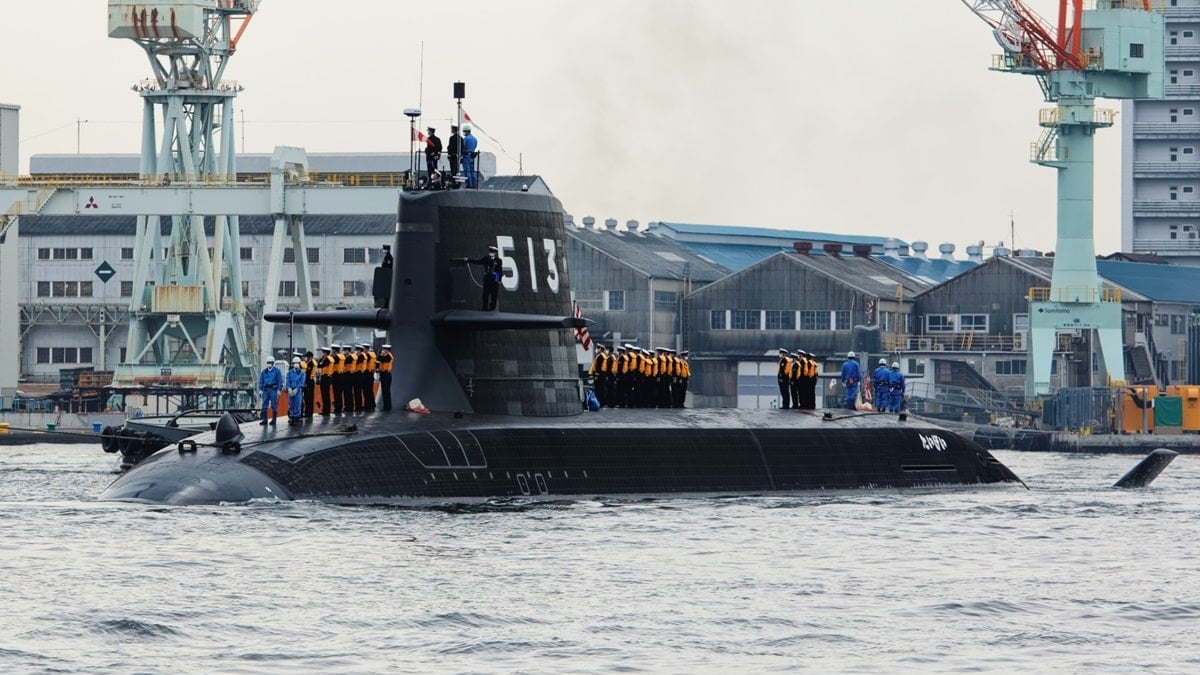Taigei-Class: Japan's New Attack Submarine Should Make China Worry
The latest Raigei “Thunder Whale” Taigei-class submarine is expected to enter service with Japan in 2025. China will watch their development closely.
In October, Japan’s newest Taigei-class attack submarine reached a new milestone. During a ceremony at manufacturer Kawasaki Heavy Industries in Kobe City, Japan’s Maritime Self-Defense Force launched its Raigei SS 516 SSN. Japan’s Taigei-class ships are fitted primarily with lithium-ion batteries, which gives these submarines the ability to travel faster and at longer speeds underwater than conventional diesel-electric counterparts. Now that tensions in the South China Sea are peaking amidst Beijing and Pyongyang’s hostile behavior, Japan’s latest naval capabilities are vitally significant.
Taigei-class: A History of Japan’s Newest Submarine Fleet
Japan’s Taigei-class submarines succeeded the Soryu-class diesel-electric attack boats. Since 2009, this earlier series of vessels made up the country’s advanced submersible fleet. The Soryu-class has the largest displacement of any other submarine sailed by Japan since the Second World War.
While the first ten of these submarines are diesel-electric, the 11th vessel in this class represents the world’s first lithium-ion battery ship.
Back in the early 2000s, Japanese engineers began researching next-generation submarine systems that could fulfill certain cost, speed, and stealth requirements. By 2005, the first-ever program designed to create a sonar array with improved power-saving and detection abilities was initiated.
This new air-independent-propulsion (AIP) system would enable future classes of submarines to expand their operational areas, a capability deemed very significant by Japan’s Maritime Self-Defense Force.
Specs and Capabilities
The latest Raigei “Thunder Whale” Taigei-class submarine is expected to enter service with Japan in 2025.
According to state sources, the new submarine can carry a crew of about 70 sailors and measures roughly 84 meters long. Additionally, this SSN has a standard displacement of around 3,000 tonnes, which is larger than the preceding Soryu-class ships. Lithium batteries recharge faster than lead-acid batteries, which gives this newer class of submarines an edge over competitors.
The Kyoto-based battery developer GS Yyasa asserts that these lithium batteries enable submarines to have more stealth and spend longer periods in deeper waters. Furthermore, these lithium-ion batteries are expected to require much less maintenance than other vessels and provide fast-charging abilities.

Armament-wise, the Taigei-class submarines possess a range of capabilities. These ships are equipped with six HU-606 533mm torpedo tubes, which are able to fire Mitsubishi-built Type 89 heavyweight homing torpedoes in addition to UGM-48 Harpoon anti-ship missiles.
Other armaments include the Type 18 torpedo and torpedo countermeasures to enhance survivability in times of conflict. These propulsion systems incorporate a single-shade diesel-electric setup which is powered by two Kawasaki 12V 25/25 SB-type diesel engines in addition to an electric propulsion motor.

On-board sensors and radars have been detailed by Naval Technology. “The Taigei-class diesel-electric attack submarine features a high-performance sonar system for enhanced surveillance and detection capabilities. The submarine’s combat management system (CMS) uses information collected from on-board sensors for weapon engagement. The ZPS-6F surface/low-level air search radar fitted in the vessel helps to detect enemy anti-submarine warfare platforms and maritime patrol vessels. The ship is also fitted with a towed array sonar.”
What Else Do We Know About the Taigei-class?
For many years, Japan got away with possessing a relatively smaller fleet of vessels, since China’s capabilities were not as advanced. However, as the People’s Liberation Army has expanded and Beijing has poured more and more resources into modernizing its naval prowess, Tokyo’s drive to advance its arsenal makes sense.
According to reports, the PRC is already eyeing the use of lithium-ion batteries for its submarines. China’s ships already feature an air-independent propulsion system that enables its vessels to create oxygen underwater.
While the introduction of the Raigei is an important milestone for Japan’s naval capabilities, its Taigei-class submarine program is still new.
The lead vessel of this class, the Taigei SS 513, was commissioned in 2022. The second ship in this class, the Hakugei SS 514, entered service one year later in March 2023.
The third ship in this class, the Jingei SS 515, is expected to hit the waters by March 2024.
As tensions between Washington and Beijing continue to ramp up, the capabilities of American allied fleets in the region will become more significant. The Japanese-American alliance deeply concerns the PRC, as officials have more than one advanced Navy to worry about in terms of the possibility of a future kinetic conflict.
Maya Carlin is an analyst with the Center for Security Policy and a former Anna Sobol Levy Fellow at IDC Herzliya in Israel. She has by-lines in many publications, including The National Interest, Jerusalem Post, and Times of Israel. You can follow her on Twitter: @MayaCarlin.
All images are Creative Commons.


